Conceptual work
Video- and 3D installations, art als applied philosophy.
uit 2006 tot 2025
(klik op de afbeelding om het werk groter te bekijken)
stuur een bericht

Meatlove
2025Meatlove examines how contemporary culture packages and immobilizes emotions, despite their intrinsic instability. The gold slogan echoes the language of luxury branding, but clashes with the slowly shifting organic core. The work presents love as something we attempt to freeze — in symbols, in objects, in rituals — even though it continuously transforms, decays, and slips beyond containment. The sculpture holds this tension in a play of gloss, irony, and quiet dissonance. Meatlove is a compact sculptural work that explores the boundary between affection, consumption, and the illusion of permanence. A heart-shaped mass of raw minced meat is suspended within a transparent resin block above a thin layer of vivid pink pigment. The sculpture rests on a white 3D-printed plinth bearing the phrase “Love Never Expires” in glossy gold lettering. While the object suggests preservation and timelessness, it contains a quiet contradiction: even within airtight resin, the meat undergoes a slow, internal process of decomposition. These subtle, long-term changes—barely visible yet inevitable—undermine the coded promise of “no expiry.” The work thus becomes a paradoxical object that simulates eternity while betraying its own fragile materiality.

Theologia Negativa
2025
Theologia Negativa presents a two-part meditation on presence, absence, and the limits of representation.
On the left, an antique devotional frame preserves not a crucifix but its lingering imprint—a darkened void where the object once rested. This absence is not a lack but a charged negative form, a trace that holds the memory of a vanished presence. The emptiness becomes the work’s first gesture: meaning articulated through withdrawal.
The object on the right offers a material counterpart to this void. Suspended within a transparent resin block is a 3D-printed replica of the missing crucifix. During the curing process, the cross drifted off-center, resisting ideal alignment and appearing caught in a subtle state of displacement. Because the printed form slightly protrudes from the resin’s surface, a faint shadow forms behind it when mounted on the wall—an unstable echo of the “original” whose absence is preserved in the frame.
Rather than affirming either the original or its copy, Theologia Negativa situates the viewer in the gap between them. This space of non-coincidence—between what was, what remains, and what can only be imperfectly remade—functions as a quiet inquiry into the nature of revelation. Meaning emerges not from the solidity of the cross but from its refusal to appear fully in either object, inviting contemplation of what remains unknowable, unrepresentable, and withdrawn.

Equity is not equality
2025Equity Is Not Equality uses the visual language of kitsch and erotica to poke fun at one of today’s most moralised social concepts. Two seemingly identical nipple pasties are preserved in a clear resin block, illuminated like museum specimens. At first sight, they form a playful, decorative pair—until the viewer notices that one tassel hangs slightly lower than the other. This subtle imbalance mimics the familiar infographic used in social justice debates, where children of different heights stand on boxes to illustrate the difference between equality and equity. By replacing the didactic cartoon with erotic, low-culture objects, the work exposes how serious political ideas are often reduced to simplified, almost cartoonish imagery. The polished display—frozen in resin, clinically lit—parodies the authoritative tone with which such concepts are presented in public discourse. Equity Is Not Equality questions whether our moral frameworks are genuinely understood, or merely consumed as ready-made, feel-good narratives. Through irony, it invites viewers to reflect on how ideology, activism, and aesthetics intertwine within contemporary culture.
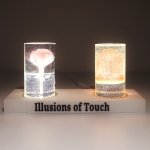
Illusions of touch
2025The installation presents a tongue and a lollipop, each encapsulated in transparent epoxy. Illuminated from below, the objects appear frozen in time, suspended in a closeness that never turns into contact. Instantly, the mind supplies the missing act: we anticipate the gesture, yet it never occurs. Illusions of Touch investigates the active role of the observer in constructing meaning. The work reveals how perception projects invisible connections onto objects and how we act on expectations and associations that never materialize. It highlights the tension between presence and absence, between reality and mental reconstruction, confronting viewers with the limits and illusions of perception. By isolating and freezing an everyday scenario—a tongue poised to lick a lollipop—the installation makes automatic anticipation and expectation visible as phenomena independent of material action. The work invites reflection on how we create meaning, forge connections, and nurture expectations, even when reality fundamentally contradicts them.

La Mécanique du Manque
2025
La Mécanique du Manque is a miniature machine of desire, enveloped in a sensual glow.
A silicone mouth beneath a clear layer of resin extends its tongue towards a lollipop suspended from a spring, held just out of reach. The candy never fully touches the tongue; it remains almost, forever on the verge of satisfaction. The LED shadow-lighting — a warm, sunset-like reddish tone — casts an uncanny atmosphere, as if the scene unfolds at a charged twilight moment of anticipation, desire, and unease.
This subtle mechanism materialises a key notion in Lacanian psychoanalysis: desire is sustained not by fulfilment, but by the lack that keeps it alive. It is the oscillation between nearness and denial that nourishes the longing. The spring mechanises this manque, ensuring that pleasure remains almost, never fully attained.
The erotic tension introduced by the light engages the viewer not only conceptually, but viscerally. The piece becomes a mechanism that seduces while receding — a machine not designed to gratify, but to never stop desiring.

La Revanche de l'Objet
2025A glossy black jewelry bust presents a necklace as an object of desire. Yet instead of precious stones, the pendant contains artificial teeth, carefully cast in transparent resin. The body has vanished, but its simulacrum gleams. The work refers to Jean Baudrillard’s idea of la revanche de l’objet: the moment when objects withdraw from the use and meaning values once assigned to them by humans, and assume their own symbolic logic, increasingly directing our thought, our existence, and our identity. The teeth — signs of vitality, beauty, and aggression — here become mere surface, image, fetish. Their glossy white perfection further reflects the contemporary obsession with unattainable eternal youth and imperishable beauty in a commodified world. They seem to gaze back, exposing the viewer’s own fascination with the false, the shiny, the seemingly real. The white pedestal serves as a neutral stage for a quiet rebellion: the triumph of the object over the human, of appearance over truth.

L’Inconnue de la Seine – Précession des simulacres
2025This installation revisits the myth of L’Inconnue de la Seine as an early precursor of what Jean Baudrillard later described as the precession of simulacra: the disappearance of the original beneath an endless chain of reproductions. On the left, a lithophane shows the supposed face of the drowned unknown girl – itself already a reproduction of a questionable death mask. On the right, three 3D-printed masks are generated by AI from increasingly blurred photographs of that image. As each version drifts further away from the source, it paradoxically gains a sense of authenticity, as if a new truth emerges independent of any origin. Just like the legend of L’Inconnue – with no certainty about who she was, nor whether the mask was ever real – images today circulate as signs without reference. Copies give birth to new copies. The original is no longer a starting point, but a rumour. The work reveals how images not only survive but grow stronger as they detach from their source. The simulacrum replaces the real – and we barely notice the loss.
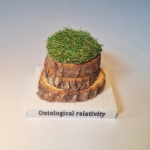
Ontological Relativity
2025This sculptural work explores the philosophical notion of ontological relativity, as proposed by W.V.O. Quine. It consists of three stacked wooden discs resembling tree trunk slices, topped with a patch of artificial grass. The entire structure is mounted on a white 3D printed base bearing the phrase “Ontological relativity.” The viewer is invited to interpret the layered discs either as slices of a tree trunk or as geological sediment layers. This ambiguity illustrates how the same sensory data can yield different meanings depending on the conceptual framework imposed. The grass atop the structure evokes life or surface reality—complicating the ontological reading. Quine’s theory suggests that what exists is not absolute, but relative to the language and theory used to describe it. This work materializes that idea: the object remains constant, but its meaning shifts with the viewer’s interpretive lens. It becomes a prompt for reflection on how we construct reality through language, theory, and perception.

Post hoc ergo propter hoc (ter)
2025Post Hoc Ergo Propter Hoc is a reflective installation on the human impulse to construct causality from coincidence. A dual-channel video loop shows two isolated events: on the left, a match suddenly ignites; on the right, a candle begins to burn moments later. The scale and brightness of both images are identical, yet they remain separated, suspended in their own visual fields. No flame ever touches the candle. There is only a temporal sequence — a mere juxtaposition in time. Still, the mind instinctively forges a causal link: the match must have lit the candle. Beneath the projection, a 3D-printed platform holds a match and a candle, cast in resin. Frozen in their material stillness, they cannot physically interact. Their petrified presence further destabilises the viewer’s expectation of cause and effect. By provoking and then undermining the assumption of causal necessity, the work echoes David Hume’s critique: that causation is not a property of the world, but a habit of the mind — an interpretative glue applied to successive perceptions. What appears as a chain of events may be nothing more than correlation, coincidence, or narrative desire. Post Hoc Ergo Propter Hoc invites us to reconsider the certainty with which we attribute meaning, agency, and explanation to the world. It challenges the foundation upon which much of our reasoning rests, exposing how fragile, constructed, and illusory the notion of causality can be.

L'embarras du choix
2025l’embarras du choix consists of three similar sculptural objects presented simultaneously, staged in a shop or showroom-like setting. Each object features a pierced silicone nipple encased in transparent pink-tinted resin and placed on a white pedestal of varying scale. The work examines how desire, intimacy, and the body are transformed into consumable units. The silicone nipple carries connotations of affect and eroticism, but through casting and resin it becomes immobilized and preserved. Piercings suggest individuality, while serial presentation neutralizes it. Desire is neither celebrated nor censored, but archived. The dried flowers introduce an exhausted form of care. Traditionally associated with vitality, affection, or mourning, they function here as styling devices: care reduced to decoration. They point to tenderness after usefulness has expired. The installation aligns with postmodern critiques of consumption and simulation, notably those articulated by Jean Baudrillard. Rather than spectacle, the work presents a quiet economic structure in which the body appears as merchandise and choice as ritual.

The politics of the flesh
2025The Politics of the Flesh explores the ways in which religious and societal norms shape our perception of the human body. The work presents two framed objects: on the left, a silicone cast of a female vulva; on the right, an artificial accessory worn inside underwear to create a “perfect” camel-toe silhouette. Each object is labeled “Haram” and “Halal”. By marking the natural body as “forbidden” and the artificial as “permitted”, the installation exposes the paradoxes and absurdities of moral systems rooted in the Abrahamic religions. These systems reward modesty, concealment, and simulation, while condemning the real, living body. Modesty cultures repress the direct visibility of the female body, but simultaneously stimulate a covert demand for sexualized signs. The work reveals how notions of purity, shame, and propriety are not universal truths, but cultural constructions designed to regulate and control the body. The Politics of the Flesh questions who holds the authority to define what is “decent”, “moral”, or “acceptable” — and highlights how the artificial can become more socially permissible than the real.

The silent spectacle of the self
2025This work presents a transparent drinking glass fully embedded in a solid block of epoxy resin. Completely sealed and immobilised, the glass becomes inaccessible and stripped of all practical function. It can no longer hold liquid, serve a purpose, or mediate any human action. It stands as an object existing in isolation, withdrawn from the realm of use. In this state of preserved stillness and inaccessibility, the object touches upon what Immanuel Kant calls the Ding an sich: the thing as it exists independently of human perception, interpretation, or instrumentalisation. By removing all utility, the viewer is compelled to encounter the object not as a tool but as an autonomous entity with an unknowable inner reality. The resin acts as a paradoxical medium: it reveals while it conceals. The glass remains visible, yet radically out of reach. The work foregrounds the tension between what we believe we perceive and what actually presents itself — between phenomenon and thing-in-itself. The glass becomes a silent confrontation with our impulse to project meaning, purpose, or categorisation onto the world. Our cognition of the world is nothing more than a game of mirrors.

Outdoor Bred
2025Outdoor Bred consists of a small sculpture made from minced meat, shaped with a cookie cutter into the silhouette of a pig and permanently encapsulated within a clear resin block. The object rests on a patch of artificial grass, placed atop a tall, minimal white pedestal. At the bottom of the pedestal, printed in small and understated letters, appears the term outdoor bred. The installation stages a quiet tension between authenticity and simulation. The phrase “outdoor bred” — borrowed from agricultural marketing to imply more ethical, outdoor-based husbandry — contrasts sharply with the synthetic grass and the preserved, lifeless meat. The work gently destabilises the rhetoric of “naturalness” so frequently deployed in food branding and ethical consumption. By fixing the meat in resin, the piece grants an illusion of permanence to a fundamentally perishable substance. The disproportion between the monumentality of the pedestal and the fragile scale of the object creates a dissonance between significance and banality. Outdoor Bred becomes a critique of the ways in which terms, images, and materials construct the appearance of purity or ethics, even when the underlying reality remains unresolved.

Civilization
2025Civilization is a miniature equestrian sculpture referencing the numerous public monuments of King Leopold II that still populate Belgium’s urban landscape. The work depicts a white rider on horseback, rendered in glossy white 3D-printed material that evokes a sterile, museum-like purity. The surface of the pedestal is filled with a deep red resin layer, symbolizing the bloodshed caused by the colonial regime of the Congo Free State (1885–1908). By reducing the monument to a small, almost toy-like scale, the work undermines the traditional monumentality and heroism typically associated with such statues. The engraved term “Civilization” on the front side highlights the colonial narrative of a “civilizing mission,” confronting the viewer with the dissonance between the official myth and the historical reality of violence, exploitation, and racial domination. Civilization questions how collective memory is constructed, sanitized, mythologized or erased — and how the aesthetics of monuments contribute to the normalization of historical crimes.

Caress for instant gratification
2025
The work expresses the human urge for comfort and physical closeness — a longing that often provides only a fleeting satisfaction without truly dissolving loneliness.
The encapsulated cluster of hair, preserved in resin, becomes a relic of intimacy: a fossil of touch, stripped of warmth, scent, and reciprocity.
The text on the base reads like both a consumer slogan and a scientific label, exposing the fragility of desire and the commodification of human connection.
The piece reflects on the tension between longing and fulfillment, between the illusion of intimacy and the unbridgeable solitude that defines the human condition.
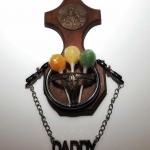
Holy Daddy
2025Holy Daddy is an assemblage merging religious devotion, eroticism, and consumer culture into a single image. On an old wooden holy water font, three colorful lollipops appear as sacred offerings, flanked by metal clamps and a silver chain spelling “DADDY”. The piece plays on the tension between worship and submission, between faith and desire. The lollipops evoke childhood innocence but here become symbols of seduction and fetish. The religious object is both desecrated and re-sacralized — transformed into a contemporary altar for consumerist eroticism. In the spirit of Baudrillard and Bataille, Holy Daddy suggests that consumerism has become our new religion — a system in which objects, bodies, and desires are elevated to icons of salvation. Where the sacred once represented the ineffable, the consumer object now embodies a secular transcendence: the worship of pleasure and excess in a disenchanted world. Holy Daddy explores how power, pleasure, and devotion intertwine. Both the believer and the submissive seek transcendence, grounding, and surrender. The work questions whether modern consumption and sexuality have become our new rituals of worship — ecstatic gestures in a godless age.
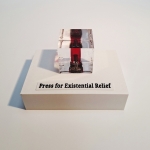
Press for Existential Relief
2025Press for Existential Relief is a sculptural installation consisting of a red toggle switch encased in clear epoxy resin, mounted on a white 3D printed pedestal. A brass plaque beneath the object reads: “Press for Existential Relief.” The work stages a tension between promise and impossibility. The viewer is instructed to perform an action that cannot be realized. The inscription suggests an instant remedy for existential dread, yet the resin denies any possibility of activation. The installation confronts the absurdity of seeking technical or simplistic solutions to existential anguish. The fear of meaninglessness and nothingness cannot be solved by pushing a button, nor by any mechanical or rational means. The piece oscillates between irony and gravity, exposing the human craving for relief and meaning as a frustrated but inextinguishable drive.
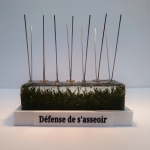
Défense de s'asseoir
2025A patch of artificial grass, inviting and familiar, is cast in resin and pierced by metal spikes. What promises comfort and accessibility is instantly withdrawn, transformed into a surface of exclusion. The inscription “Défense de s’asseoir” makes explicit what the object already declares. Normally, prohibition operates in a single register: either through text (law, language) or through material impediment (spikes, physical force). Here, both are imposed simultaneously, a double prohibition that renders the interdiction excessive and even absurd. The work refers to hostile architecture: urban strategies that prevent rest, gathering, or shelter, often targeting the most vulnerable. In this miniature, it becomes clear that control in public space is never neutral: hospitality is evoked only to be withdrawn, freedom promised only to be denied.

Beyond the pleasure principle
2025A used condom containing traces of semen is preserved in a transparent resin cube. It rests on a bed of red glitter hearts — symbols of romantic love, mass-produced and disposable — and is framed like a biological artifact, titled Specimen No. 0001. The work juxtaposes the intimate with the clinical, the emotional with the absurd, the transient with the eternal. By fossilizing a remnant of sexual activity and placing it in a mock-scientific, kitsch-laden context, the piece invites reflection on the contradiction between human meaning-making and nature’s impersonal reproductive logic. Are we lovers, agents, or just vehicles and vectors for DNA? In this sterile reliquary, even desire becomes evidence, and love is reduced to packaging.
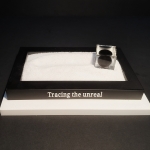
Tracing the unreal
2025This installation presents an apparently simple scene: a black platform filled with white sand, bearing the clear trace of a rolling object — a curved line ending at a transparent cube that encloses a ball. The visual impression immediately suggests a causal link: the ball must have rolled and left its trace in the sand. But this assumption is misleading. As the ball is entirely embedded in resin, it could not have moved. The work confronts the viewer with their own cognitive automatisms. Drawing on the philosophies of David Hume and Immanuel Kant, it questions the immediacy with which we perceive causal relationships in the world around us. For Hume, causality is not an objective feature of reality, but a habit of the mind: we expect a cause whenever we see an effect. Kant goes further: the human mind projects categories such as causality onto experience — we cannot help but think in terms of cause and effect. Tracing the Unreal renders this mental projection visible. The installation is a visual paradox, a silent trap for thought: what appears self-evident turns out to be impossible. In the tension between perception and reality, between thinking and knowing, space opens up for doubt — and wonder.

Das Nichts nichtet
2025This installation stages a stark philosophical scene: a solitary black chair stands on a white platform, facing a glowing lightbox bearing the phrase “DAS NICHTS NICHTET”. Along the edge of the platform, the French inscription “Cours de métaphysique avancée” (Advanced Metaphysics Course) introduces a subtle irony. The title is drawn from Martin Heidegger’s seminal 1929 lecture What is Metaphysics?, in which he asserts that the Nothing (das Nichts) is not mere absence, but something that “nihilates” — it nothings. In Heidegger’s thought, the Nothing plays a crucial ontological role: it discloses Being by confronting Dasein with the possibility of meaninglessness. The black chair represents the absent spectator or student, evoking an atmosphere of existential quietude: an advanced metaphysics course without lecturer, without content — only the confrontation with absence, with light, with the word. Positioned between philosophical diagram and silent theater, the work invites reflection on the active role of Nothingness in our experience of Being, and on the strange intimacy between language, void, and presence.

Objet a
2025Objet a is a sculptural installation that interrogates desire and consumer culture through a psychoanalytic lens. At its center is a silicone tongue, suspended in front of a mirror framed by lightbulbs like a vanity or store display. Beneath the mirror, the inscription Objet a references Jacques Lacan’s theory of the elusive object of desire — the unattainable “thing” that fuels longing but can never truly be possessed. The mirror also invokes Lacan’s famous mirror stage, the formative moment when the child first recognizes itself in a reflected image. This recognition is also a misrecognition: the self is seen from the outside, as an image that is coherent yet alien. In Objet a, this paradox is made tangible — the tongue reaches toward its own reflection, a gesture of desire toward an unreachable other, or toward the self as other. In front of the mirror lies a lollipop: a symbol of childish craving, consumer indulgence, and the endless cycle of promise and lack. The installation plays with seduction and frustration, with the mirror serving as a stage for both self-recognition and estrangement. By using playful and artificial materials — a plastic tongue, a glossy frame, a cheap piece of candy — Objet a raises pointed questions about how desire is constructed, aestheticized, and commodified in contemporary visual culture.

Eidolon of an Eidolon
2025The installation presents four iterations of a single subject: a cactus. A living cactus is accompanied by a technical drawing, a 3D-printed replica, and a lithophane — each a distinct mode of representation. The work stages a visual dialogue between reality and its reproductions, inviting reflection on how objects are perceived, abstracted, and reimagined. Concept: Drawing on Plato’s theory of forms, Eidolon of an Eidolon explores the layered nature of representation. In Platonic terms, physical objects are already imperfect reflections — eidolons — of ideal, abstract forms. Thus, the drawing, 3D print, and lithophane are not merely copies of the cactus, but copies of a copy: eidolons of eidolons. The installation questions the authority of the “real” and the fidelity of its representations. Each medium introduces its own distortions and conventions, revealing that perception is always mediated. The work becomes a quiet philosophical inquiry into the nature of truth, form, and the limits of seeing. “As being is to becoming, so is truth to belief.” — Plato, Timaeus (29c)

Machines désirantes
2025Machines Désirantes consists of a soft, flesh-colored sculpture of an extended tongue, placed on a rotating platform with a mirrored surface. Just above it hangs a red lollipop, suspended from an almost invisible thread. Cast in resin, the lollipop is permanently unreachable. The tongue turns endlessly, never able to attain its object of desire. The installation is surrounded by red, kitschy flowers, heightening the work’s ironic interplay between seduction, excess, and artificiality. The installation portrays the human being as a desiring machine — a system that keeps functioning even when satisfaction is impossible. In its apparent simplicity, the work evokes psychosexual tension, childlike craving, and ironic tragedy. The tongue becomes both a body part and a symbol: expressive, erotic, and helplessly driven. The title refers to the concept of desiring-machines from Anti-Oedipus by Gilles Deleuze and Félix Guattari. For them, the subject is not a coherent individual but an assemblage of drives, flows, and lack. In late capitalism, as they argue, we are all reduced to productive components in an economic system that constantly stimulates desire but never fulfills it. In Machines Désirantes, this becomes visible and tangible — an eternal orbit around a materialized absence.

The Art of Conversation
2025This work reflects on the philosophical tension between presence and absence in human communication. The lightboxes — mass-produced consumer objects — are stripped of their original function and recontextualized to express emotional urgency. Their mirrored positioning suggests reciprocity, yet their silence underscores the fragility of dialogue. The phrase “PLEASE TALK TO ME” is both invitation and lament. It echoes existential themes: the desire to be acknowledged, the fear of isolation, and the constructed nature of meaning. Inspired by thinkers like Martin Buber and Ludwig Wittgenstein, the piece questions whether true conversation is ever possible — or whether we merely perform the illusion of understanding.

A picture held us captive. (Philosophical Investigations, §115)
2025This 3D printed artwork explores the tension between language, meaning, and reality through an internal paradox. The billboard firmly states: "There is no left. There is no right."—a claim that seems to suggest that the concepts of ‘left’ and ‘right’ are not absolute or objective but depend on context, language use, and perspective. Yet, the work immediately undermines this assertion by placing the words "Left" and "Right" on the platform beneath the sign, presenting these concepts as fixed points of reference. This tension closely aligns with Ludwig Wittgenstein’s ideas on language and meaning. In his Philosophical Investigations, he argues that the meaning of a word arises from its use within a language game. ‘Left’ and ‘right’ do not possess an intrinsic, universal essence; rather, they acquire meaning through how we apply them. The billboard appears to embrace this idea by denying the existence of ‘left’ and ‘right’ as absolute categories. Yet at the same time, the artwork reveals how difficult it is to think outside such concepts—the words on the platform still force us into a binary orientation. This creates a paradox: if left and right do not exist, why are they named? In this way, the artwork exposes how language both enables and constrains our thinking.
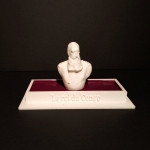
Cenotaph for a People
2025Cenotaph for a People is a sculptural installation confronting the violent colonial legacy of the Congo Free State under King Leopold II of Belgium. The work features a white 3D-printed bust of Leopold II, mounted on a base inscribed with the phrase Le roi du Congo ("The King of the Congo"). In front of the bust lies a pool of red clotted blood—thick, opaque, and darkly symbolic. The entire work is sealed beneath a layer of clear epoxy, preserving its pristine yet disturbing aesthetic and invoking the frozen silence of historical forgetting.
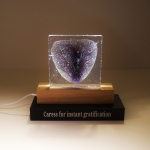
Caress for instant gratification bis
2025
Epoxy resin with embedded artificial pubic hair, wooden base with integrated LED lighting, black plinth with inscription “Caress for instant gratification.”
The lighting transforms the encapsulated hair mass into a relic — a bodily trace suspended between sanctity and banality. The resin’s glow both seduces and distances: intimacy becomes sublime, eroticism becomes sterile.
The work reflects on our longing to preserve closeness, to hold on to warmth in a cold world. Yet the touch never arrives. The title refers ironically to the digital and emotional culture of instant satisfaction, where intimacy is reduced to image, object, and memory.
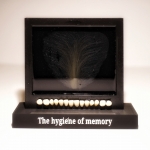
The hygiene of memory
2025Within a rigid 3D printed, black frame filled with resin, a tuft of artificial pubic hair is preserved. Along the lower edge, a straight line of artificial teeth is aligned, cold and repetitive. These elements evoke intimacy, the body, and memory, yet their artificiality undermines their authenticity. The work reflects on how memory is “hygienized”: emotion and corporeality are reduced to objects, preserved as specimens in a clinical archive. A tension emerges between intimacy and distance, relic and reproduction, life and simulation.
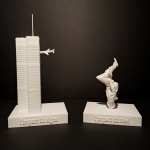
L'impact du signe
2025This 3D-printed installation questions whether the 9/11 attacks can still be seen as real events, or only as hyperreal images etched into collective memory. Inspired by Jean Baudrillard, it explores how the airplane and towers have become signs—icons in a media spectacle that transcends reality. The physical attachment of the plane to the tower emphasizes that it was not the object itself that struck, but its symbolic force. As Baudrillard wrote: “Reality itself has surpassed itself in its own simulacrum.” The installation reflects on how events are shaped, distorted, and fixed within image, media, and memory. The statue of the Falling Man adds a deeply human and existential dimension to the installation. The choice of the World Trade Center was not just strategic, but symbolic: a monument of Western economic power and globalization. The attack was a spectacle, aimed at disrupting the symbolic order. Its violence was designed to generate meaning—to create an iconic image that would flood the world. In this sense, the event took place primarily in the realm of representation, not material reality.

Physis
2025Physis, derived from phyō ("to grow"), in Pre-Socratic philosophy referred to an inner process of becoming and unfolding. Nature was not a static given but a dynamic force with its own drive for development. This contrasts with the modern scientific view, which sees nature as a mechanical system, explainable through laws and causality. The ancient concept of physis is revived in ecological thinking, where nature is not merely an object but a network of interactions and emergent processes. This installation confronts the viewer with the boundary between life and lifelessness, growth and stillness. By placing the coral on a platform and introducing minimal movement through an AI-generated video, the viewer is invited to reflect on how we understand and perceive nature. Here, physis is not conceived as a collection of objects but as a process—a continuous dynamic of formation, transformation, and transience. The installation encourages the viewer to break away from the modern scientific perspective, in which nature is primarily understood in terms of lifeless matter and fixed laws. By giving the coral a subtle, almost imperceptible motion, we are challenged to look and experience anew - to unlearn and unsee what we thought we understood.

Politique Indigène
2025Politique Indigène reconstructs Léon Rom’s notorious colonial residence and the yard where a gallows once stood, using 3D printing techniques. Rom, infamous for his brutality in the Congo Free State, decorated his home with skulls, becoming a symbol of the systemic oppression and atrocities of Belgian colonialism. The diorama's are presented together with a video that alternates between historical footage and AI-generated scenes, presenting an idealized, fictionalized version of colonization. The interactions between colonizers and locals appear peaceful yet remain deeply paternalistic and disruptive. The video reflects the politique indigène, a colonial policy that gave the illusion of autonomy for the indigenous population while maintaining control through coercion. It reveals how this policy concealed the oppression at the heart of Belgian colonialism. By blending historical footage with AI-generated content, Politique Indigène invites viewers to question how colonial history is remembered and presented. The work critiques how histories are reconstructed and how personal and geopolitical narratives shape our understanding of the past. It offers a critical visualization of the Belgian colonial project and encourages reflection on its enduring impact.

The ontology of truth 2
2025In The Ontology of Truth, the artist presents a white 3D printed cube embedded with six hyperrealistic nipples in three different skin tones. Each tone appears twice, always on opposing sides. Each nipple is also uniquely pierced. The cube is tilted on its pedestal, denying any neutral orientation and forcing the viewer into a specific perspective. The work playfully and ironically references Heidegger’s notion of aletheia — truth as both disclosure and concealment. At any given moment, only three sides of a cube can be seen; to reveal one aspect is necessarily to obscure another. The piece thus suggests that truth is not a fixed entity but a situation — a perspectival condition, contingent on location, position, and viewer. From every angle, three distinct skin tones are visible, but due to the unique piercings, no two perspectives are the same. The bodies in the work — vulnerable, intimate, adorned, particular — return truth to the tactile, the corporeal, the human. Each piercing, each contrast of color, forms a micro-narrative. Together, they underscore the idea that what we see is always only a fragment of what is.

Qualitas Occultae
2025Qualitas Occultae is an interactive light-based installation that explores the invisible forces shaping our world, inspired by Newton’s concept of gravity and a childhood fascination with remote activation. The work features a small “flip-flap” figure under a glass dome, powered by a photovoltaic element. When the space is empty, the figure remains still. However, a motion sensor triggers a strong directional light as visitors enter, illuminating the dome and causing the figure to move, seemingly animated by an unseen force. This installation reflects on the mystery of action at a distance, a concept central to Newton’s understanding of nature but rejected by Leibniz, who dismissed it as an occult property. The piece also evokes the wonder of childhood discovery, like the marvel of solar panels and remote controls—technologies that enable objects to move without direct contact. By allowing viewers to witness a simple yet magical transformation, Action at a Distance seeks to reignite awe at the hidden forces governing our reality, much like Newton’s contemporaries once questioned how gravity could act across empty space. In an age where technology has made the extraordinary routine, this work encourages us to pause and rediscover the mysteries that quietly shape our world. Balancing scientific explanation with a sense of magic in natural phenomena, the installation invites us to reconnect with the marvel of the unseen.

The Anatomy of Absent Causes
2025The Anatomy of Absent Causes is an installation that examines our innate tendency to construct causal narratives from fragmentary observations. Even when no action or event is shown, we instinctively fill the void with a story that imposes order and meaning. This work makes that cognitive reflex both visible and tangible. On a white plinth, with the title embossed along the front, sit two transparent cast-resin blocks. One contains a cracked eggshell, positioned with the precision of a scientific specimen. The other encases a metal spoon, equally stripped of context and functionality. Through this act of preservation, the objects are presented as archival evidence, removed from any timeline or event that could connect them. By freezing the objects in time, the installation intensifies its conceptual aim: the viewer encounters only the aftermath, never the cause. The mind seizes this absence and constructs a plausible narrative — a process that the Scottish philosopher David Hume described as a habit of the mind rather than a property of the world. The work exposes this automatic projection: we interpret, connect, and reconstruct even when factual linkage is missing. The installation invites a slower gaze and encourages self-awareness: what do we truly perceive, and what do we mentally supply?

All the things you cannot see
2024The video installation centers on an interview with a young woman discussing anxiety, disorientation, loss of control, and psychological splitting. She describes fears of being observed and judged. Using brief found footage segments, the installation visualizes her condition, reflecting universal fears and uncertainties. By juxtaposing visually analogous fragments, the work highlights the metaphorical nature of thought. Scientists appear as symbols of power in psychology, exposing the illusion of objectivity and its role in creating hierarchical, dehumanizing dynamics. The metaphor of fermentation prompts reflection on the limits of knowledge, the ontology of the unobservable, and how conceptual frameworks shape understanding and power structures. Next to the video stands a small figurine of the woman who plays the central role. Her portrait was scanned using AI, and the sculpture was realized in 3D-printed PLA, combined with wax. It is placed on a pedestal into which an LED light has been integrated.
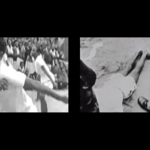
Tête-de-Nègre/White Innocence
2022The video installation consists of three sequences of images, based on found footage from Belgium's colonial history and American visual culture. The images make visible the binary, moral-theoretical oppositions that constitute Western thought (e.g., civilized-savage, uninhibited-disciplined, white-black, rational-emotional). In this way, the work seeks to reveal the associative fields and cultural archives (a term from Edward Said) that underpin the dominant Western self-image. The images construct a semi-imaginary history, a "theory-fiction" that indirectly and obliquely highlights certain aspects of historical and social reality. However, attempting to interpret the images literally, factually, or historically is futile. Above all, the work aims to evoke a sense of estrangement and alienation in the viewer, potentially prompting reflection on the racial ideologies and stereotypes that, often unconsciously, shape our thinking.
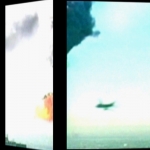
Post hoc ergo propter hoc (bis)
2013Double projection. The two images are projected onto a pillar-shaped structure, positioned at a 90-degree angle to each other. By temporally and spatially unraveling an iconic image—the WTC attack—the work questions the relationship between correlation and causality. As David Hume already observed, we perceive only the succession of events, not the causal connection itself.

Tussen hangen en vallen
2006Single channel video. 'Tussen hangen en vallen' is an old fishermen’s saying that refers to the moment just before sunset. This state of uncertainty serves as a metaphor for the condition humaine: for an existence in suspension.
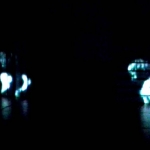
Différance
2006Double projections on random surfaces, intermittently synchronized, create moments of fleeting harmony. This interplay evokes Derrida’s différance, the continual shifting between sameness and difference through which meaning emerges. Simultaneously, it reflects Kierkegaard’s infinite interestedness—the existential striving to reconcile the finite and the infinite, the temporal and the eternal. In both cases, tension and oscillation are not problems to be solved but processes to be inhabited: the video enacts the rhythm of meaning and existence in flux, revealing harmony that arises only in the movement between opposites.
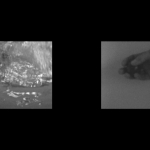
Post hoc ergo propter hoc
2006Double projection, in which a visual and mental association is evoked that questions the relationship between correlation and causation. By detaching the time dimension from, on the one hand, the hand releasing the ball and, on the other, the ball falling into the water, the mechanism of causal interpretation is called into question. It reveals that causality is, first and foremost, rooted in a mental reflex.